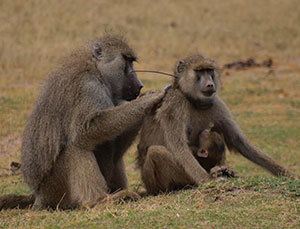

Both scientific research and our own personal experiences have revealed that the strength and quality of a person’s social relationships can affect their health and lifespan. Now a new collaborative study by researchers at the University of Notre Dame, Duke University and Princeton University has discovered that social interconnectedness also matters for survival in wild female baboons. And the findings may also be applicable to other social mammals.
Elizabeth Archie, Clare Booth Luce Assistant Professor in the Department of Biological Sciences at Notre Dame, and colleagues used an incredibly rich data set on the social relationships of wild baboons which was collected on an almost daily basis, year-round, since 1984 by the Amboseli Baboon Research Project. The project, which Archie helps direct, is a long-term study of wild baboons that follows the lives of individual baboons, watching what they do and who they interact with.
“We can tell individual baboons apart by distinct features of their appearance, such as their fur color, the shape of their tail, or how they move,” Archie said. “We especially focused on grooming interactions, which are a sign of social support in baboons. Baboons spend more time grooming their ‘friends’, and baboons with stronger grooming connections seem to live longer.”
The Archie group’s analysis of the data set found that females who were socially connected to both adult males and females lived longer than females with weak ties to one or both sexes.
The study begs the question of why to study female rather than male, or both sexes of baboons.

“We’re hoping to do a similar study in males, but doing so is difficult because one of the key differences in the lives of male versus female baboons,” Archie said, “Specifically, female baboons live in the same social group for their whole lives, so when they disappear from the group, we can be pretty certain that they died. This fact allows us to measure female life spans very accurately. However, male baboons often move repeatedly from one social group to another over the course of their adult life. Hence, if a male baboon disappears from the group, we can’t be certain if he died or just moved away, which makes it difficult to measure male life spans.”
Archie points out that the last few decades have brought a considerable interest in understanding how and when social relationships contribute to variation in lifespan. In humans, multiple studies have indicated that social integration and support predict both health and lifespan. However, comparable studies in non-human animals have been rare.
‘There was one big challenge to conducting a study like ours, keeping the long-term field study going over several decades to collect the data we needed,” Archie said. “Baboons in the wild can live for over 25 years, so we needed many years of data to accurately measure the baboons’ life spans. Most research grants last only for three to five years, so the directors of the project have had to work hard to keep the field project funded. Special thanks goes to Susan Alberts at Duke and Jeanne Altmann at Princeton who have been working to support the project for many years.”
Archie and her fellow researchers believe that their findings on social interconnectedness may be good news not just for baboons but for fellow species.
“I think the results are applicable to humans,” Archie said. “Specifically, there have been a handful of studies that have shown that an animal’s social connections can predict their longevity, including research on rats, dolphins and baboons. Our results help confirm this phenomenon in mammals and suggest it might be widely shared across several social species.
“In addition, we see very strong evidence that social relationships predict human lifespan. Across a range of circumstances, people who receive more social support tend to live longer than people who are socially isolated. Our results suggest that this phenomenon might be part of our shared biological history with other mammals.
The Archie group’s paper appears in the Sept. 9 edition of the journal Proceedings of the Royal Society. The research was supported by funding from the National Science Foundation.
Contact: Elizabeth Archie, 574-631-0178
Originally published by at news.nd.edu on September 10, 2014.